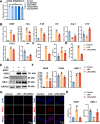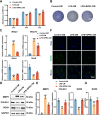S-propargyl-cysteine attenuates temporomandibular joint osteoarthritis by regulating macrophage polarization via Inhibition of JAK/STAT signaling
- PMID: 40197110
- PMCID: PMC11974036
- DOI: 10.1186/s10020-025-01186-6
S-propargyl-cysteine attenuates temporomandibular joint osteoarthritis by regulating macrophage polarization via Inhibition of JAK/STAT signaling
Erratum in
-
Correction: S-propargyl-cysteine attenuates temporomandibular joint osteoarthritis by regulating macrophage polarization via Inhibition of JAK/STAT signaling.Mol Med. 2025 Apr 28;31(1):156. doi: 10.1186/s10020-025-01214-5. Mol Med. 2025. PMID: 40295904 Free PMC article. No abstract available.
Abstract
Background: Temporomandibular joint osteoarthritis (TMJ-OA) is a disease characterized by cartilage degradation and synovial inflammation, with limited effective treatment currently. Synovial macrophage polarization is pivotal in TMJ-OA progression, making it a promising therapeutic aspect. This study investigated the effects of S-propargyl-cysteine (SPRC), an endogenous H2S donor, on macrophage polarization and its therapeutic potential in alleviating TMJ-OA.
Methods: A MIA-induced TMJ-OA rat model and LPS-stimulated RAW264.7 macrophages were employed to evaluate the effects of SPRC in vivo and in vitro. TMJ bone and cartilage were analyzed via micro-CT and histological methods, while macrophage polarization markers expression were assessed via RT-qPCR, western blot, and immunofluorescence. RNA sequencing was performed on macrophages, and the JAK2/STAT3 signaling pathway was validated using the JAK2-specific inhibitor AG490. The direct effects of SPRC on rat primary condylar chondrocytes were examined by evaluating ECM synthesis and degradation. Co-culture experiments further assessed macrophage-chondrocyte interactions.
Results: SPRC significantly alleviated cartilage and bone damage in the TMJ-OA rat model, as demonstrated by improved bone volume and cartilage structure. SPRC reduced pro-inflammatory M1 macrophage infiltration and enhanced anti-inflammatory M2 macrophage polarization. SPRC effectively inhibited the JAK2/STAT3, leading to reduction of inflammatory markers, including TNF-α, IL-6, and iNOS. Co-culture experiments revealed that SPRC-treated macrophage-conditioned medium improved chondrocyte metabolic activity and restored ECM integrity.
Conclusions: SPRC-modulated macrophage polarization alleviates TMJ-OA via JAK/STAT downregulation, thereby reducing synovial inflammation and cartilage degradation. These findings position SPRC as a promising therapeutic candidate for TMJ-OA and provide insights into novel strategies targeting macrophage polarization and synovium-cartilage crosstalk.
Keywords: Hydrogen sulfide; JAK/STAT; Macrophage; S-propargyl-cysteine; Synovial; Temporomandibular joint osteoarthritis.
© 2025. The Author(s).
Conflict of interest statement
Declarations. Ethics approval and consent to participate: This study was conducted in accordance with the Declaration of Helsinki and approved by the Guangdong HUA WEI Testing Co., Ltd. Ethics Committee (No. 202310002). Consent for publication: Not applicable. Competing interests: The authors declare no competing interests.
Figures







Similar articles
-
Fostamatinib alleviates temporomandibular joint osteoarthritis by maintaining cartilage homeostasis through MAPK/NF-κB and AKT/mTOR pathways.Int Immunopharmacol. 2025 Feb 6;147:113996. doi: 10.1016/j.intimp.2024.113996. Epub 2025 Jan 4. Int Immunopharmacol. 2025. PMID: 39756165
-
Lipoxin A4 modulates the PKA/CREB and NF-κB signaling pathway to mitigate chondrocyte catabolism and apoptosis in temporomandibular joint osteoarthritis.Exp Cell Res. 2024 Oct 1;442(2):114249. doi: 10.1016/j.yexcr.2024.114249. Epub 2024 Sep 12. Exp Cell Res. 2024. PMID: 39260675
-
Hck promotes IL-1β-induced extracellular matrix degradation, inflammation, and apoptosis in osteoarthritis via activation of the JAK-STAT3 signaling pathway.Adv Rheumatol. 2024 Dec 18;64(1):88. doi: 10.1186/s42358-024-00427-2. Adv Rheumatol. 2024. PMID: 39696562
-
The potential roles of JAK/STAT signaling in the progression of osteoarthritis.Front Endocrinol (Lausanne). 2022 Nov 24;13:1069057. doi: 10.3389/fendo.2022.1069057. eCollection 2022. Front Endocrinol (Lausanne). 2022. PMID: 36506076 Free PMC article. Review.
-
Temporomandibular Joint Osteoarthritis: Pathogenic Mechanisms Involving the Cartilage and Subchondral Bone, and Potential Therapeutic Strategies for Joint Regeneration.Int J Mol Sci. 2022 Dec 22;24(1):171. doi: 10.3390/ijms24010171. Int J Mol Sci. 2022. PMID: 36613615 Free PMC article. Review.
Cited by
-
Correction: S-propargyl-cysteine attenuates temporomandibular joint osteoarthritis by regulating macrophage polarization via Inhibition of JAK/STAT signaling.Mol Med. 2025 Apr 28;31(1):156. doi: 10.1186/s10020-025-01214-5. Mol Med. 2025. PMID: 40295904 Free PMC article. No abstract available.
References
-
- Burguera EF, Meijide-Failde R, Blanco FJ. Hydrogen sulfide and inflammatory joint diseases. Curr Drug Targets. 2017;18(14):1641–52. - PubMed
-
- Cardoneanu A, Macovei LA, Burlui AM, Mihai IR, Bratoiu I, Rezus II, Richter P, Tamba BI, Rezus E. Temporomandibular joint osteoarthritis: pathogenic mechanisms involving the cartilage and subchondral bone, and potential therapeutic strategies for joint regeneration. Int J Mol Sci 2022, 24(1). - PMC - PubMed
-
- Chen BY, Pathak JL, Lin HY, Guo WQ, Chen WJ, Luo G, Wang LJ, Sun XF, Ding Y, Li J, et al. Inflammation triggers chondrocyte ferroptosis in TMJOA via HIF-1alpha/TFRC. J Dent Res. 2024;103(7):712–22. - PubMed
-
- Cirino G, Szabo C, Papapetropoulos A. Physiological roles of hydrogen sulfide in mammalian cells, tissues, and organs. Physiol Rev. 2023;103(1):31–276. - PubMed
MeSH terms
Substances
Grants and funding
LinkOut - more resources
Full Text Sources
Medical
Miscellaneous

